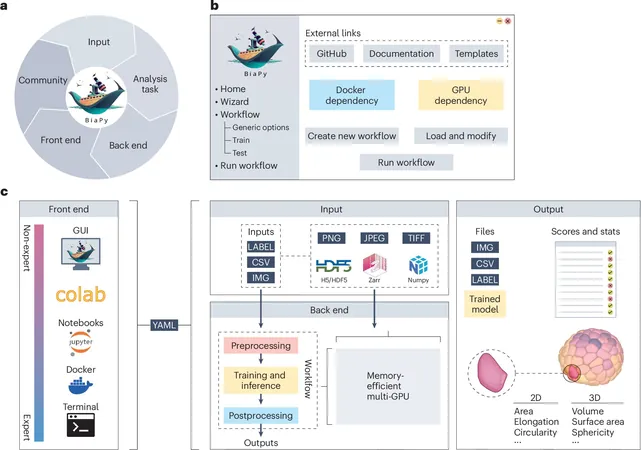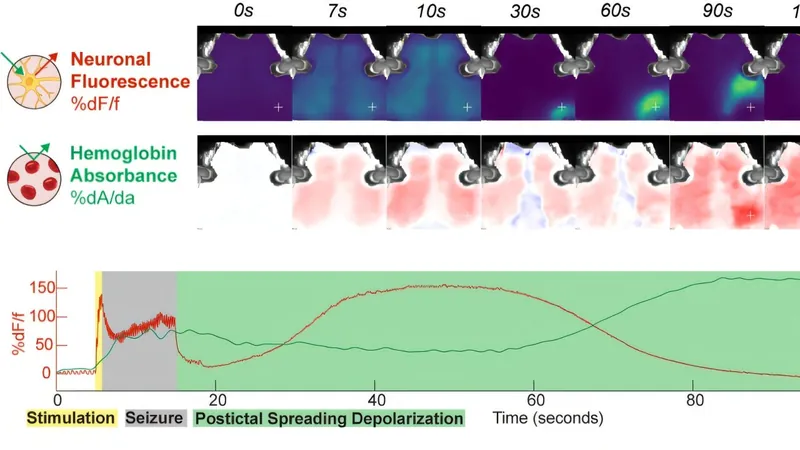
Revolutionary AI Tool Transforms Biomedical Image Analysis for Everyone
2025-04-29
Author: Arjun
Introducing BiaPy: The Game-Changer in Biomedical Imaging
An innovative coalition of researchers has unveiled BiaPy, a groundbreaking open-source AI platform designed to make biomedical image analysis accessible to all, not just coding experts. This remarkable tool employs advanced deep learning techniques and has garnered attention in the prestigious journal Nature Methods.
Breaking Down Barriers in Biomedicine
Traditionally, the benefits of AI in analyzing vital images of cells and tissues have been limited to those with programming knowledge. BiaPy shatters these barriers, offering an intuitive interface that empowers scientists and healthcare professionals to apply sophisticated AI models without needing master-level skills in programming or machine learning.
Lead author Daniel Franco from Cambridge University emphasizes the mission behind BiaPy: "We aim to democratize access to AI in bioimaging, enabling enthusiasts and experts alike to leverage this technology without being hindered by technical complexities."
Features That Accelerate Research
BiaPy is not just user-friendly; it’s also versatile. Researchers can automatically identify cellular structures, count elements, classify samples, and enhance image quality within both 2D and 3D images generated through various microscopy techniques. Whether dealing with small batches of images or vast datasets encompassing terabytes of information, BiaPy stands ready to meet the challenge.
Harnessing AI Like Never Before
At the core of BiaPy lie powerful AI models trained to discern patterns in images—functioning similarly to the human eye. By using annotated examples to train these models, BiaPy efficiently automates the analysis process, even for new, unseen images.
A Collaborative Future with BioImage Model Zoo
BiaPy enhances collaboration through integration with the BioImage Model Zoo (bioimage.io), a platform where researchers worldwide can share pre-trained models. This feature allows BiaPy users to easily repurpose existing models or develop their own with minimal effort, fostering a collaborative environment in scientific research.
Real-World Applications: Empowering Advanced Research
BiaPy is already making waves in advanced scientific projects. In collaboration with the Institute of Biomedicine of Seville, the tool aids in CartoCell, a software that deciphers intricate cellular patterns in 3D epithelial tissues across various organisms.
Another notable use is with laboratories in France, where researchers have cultivated ChroMS microscopy techniques to capture expansive 3D images of brains using luminous proteins. With BiaPy, they can automatically detect each cell within these intricate images, facilitating groundbreaking studies on brain development.
A Commitment to Open Science
As a free, open-access tool, BiaPy is readily available to scientists around the globe, enhancing collaboration and the software’s continual evolution. It is compatible with various computing platforms, including personal computers, servers, and cloud systems, making experimental replication seamless and promoting open, reproducible science.
According to Ignacio Arganda, one of the senior authors, "BiaPy epitomizes the shift toward accessible artificial computer vision in microscopy. Its user-centered design reduces technical obstacles, empowering researchers and healthcare professionals to integrate AI into their studies and significantly accelerating scientific advancements."
The Future is Bright for Biomedical Research!
With its open-code foundation and flexibility across computing environments, BiaPy is poised to revolutionize the biomedical landscape, paving the way for unprecedented innovations and breakthroughs in scientific discovery!



 Brasil (PT)
Brasil (PT)
 Canada (EN)
Canada (EN)
 Chile (ES)
Chile (ES)
 Česko (CS)
Česko (CS)
 대한민국 (KO)
대한민국 (KO)
 España (ES)
España (ES)
 France (FR)
France (FR)
 Hong Kong (EN)
Hong Kong (EN)
 Italia (IT)
Italia (IT)
 日本 (JA)
日本 (JA)
 Magyarország (HU)
Magyarország (HU)
 Norge (NO)
Norge (NO)
 Polska (PL)
Polska (PL)
 Schweiz (DE)
Schweiz (DE)
 Singapore (EN)
Singapore (EN)
 Sverige (SV)
Sverige (SV)
 Suomi (FI)
Suomi (FI)
 Türkiye (TR)
Türkiye (TR)
 الإمارات العربية المتحدة (AR)
الإمارات العربية المتحدة (AR)